Cosmonaut Training Center in Star City
On April 12, we conducted an experiment on the distribution of the Internet with the help of stratospheric probes. The experiment was observed by a thousand Habrazhiteley, many of you took part in the contest to guess where our server will land.
Vlad Vvzvlad turned out to be the closest of all; on July 20 he will go to Baikonur to see the launch of the manned spacecraft Soyuz.
The prize for the 3rd place was participation in a group excursion to the Cosmonaut Training Center in Star City. Last Friday, we were able to get there, now we are sharing the knowledge gained about the training of astronauts, how to get into the squadron, and whether it is possible to become an astronaut at all in our time.
')
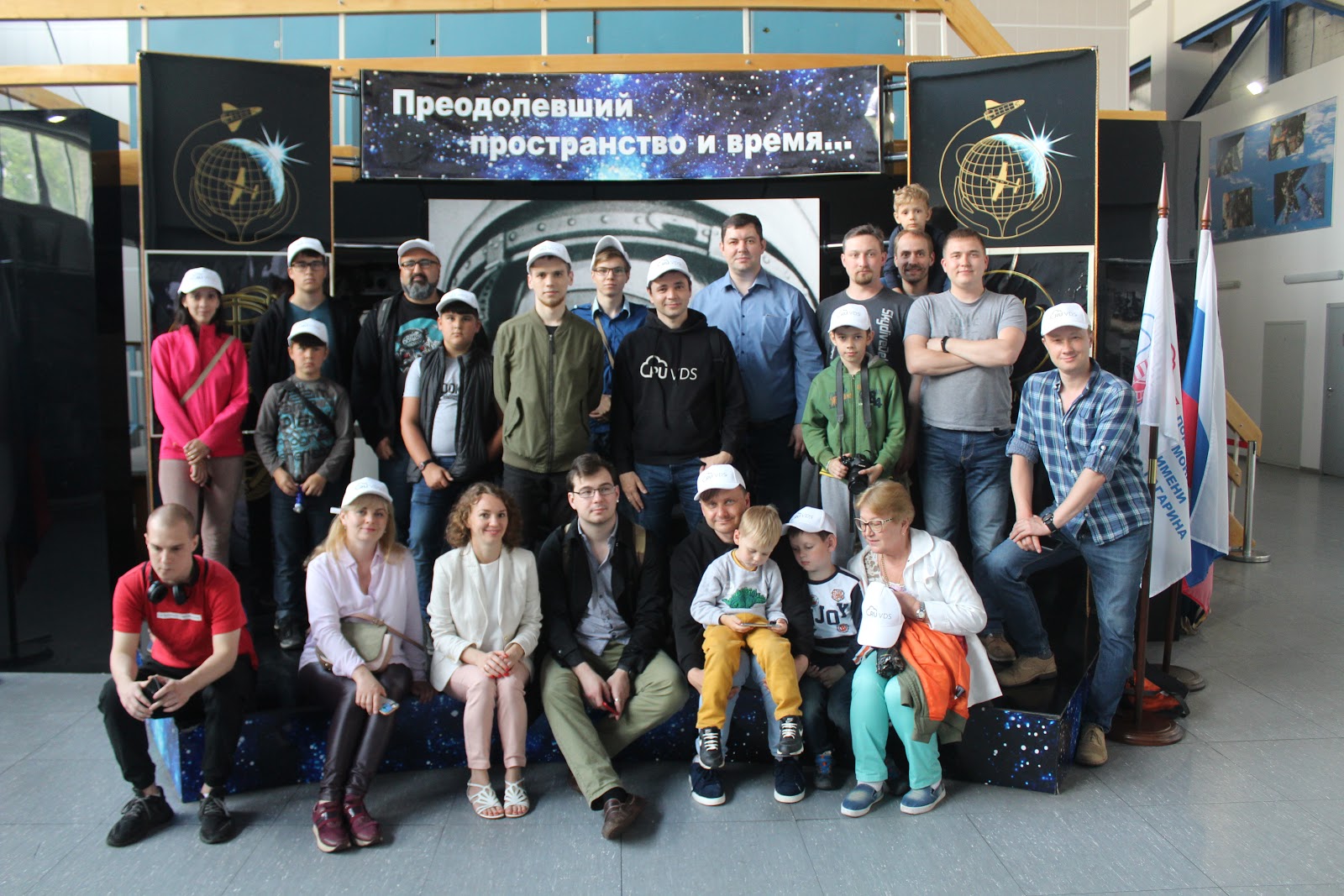
A little information about Star City. It is a closed city (about 6,000 inhabitants), here is the only Cosmonaut Training Center in Russia. All cosmonauts, including foreign ones, undergo pre-flight training for the flight to the ISS. Many astronauts in Star City not only work, but also live.
The center was established in 1960 to prepare a person for space flight, then the town was called Green, it is located next to the town of Schelkovo, 25 km from Moscow.

Our tour began with the Star City checkpoint. It is impossible to order an individual excursion at the Center; only a group tour through agencies is acquired. At the same time, we ordered a tour for 2 months, before there were no empty seats. 2 weeks before arrival you must submit a list of participants, for foreigners 45 days in advance. The document passes several approvals, we counted 9 signatures and seals on our entry sheet. Before entering the standard verification of documents, and we get to the Center.
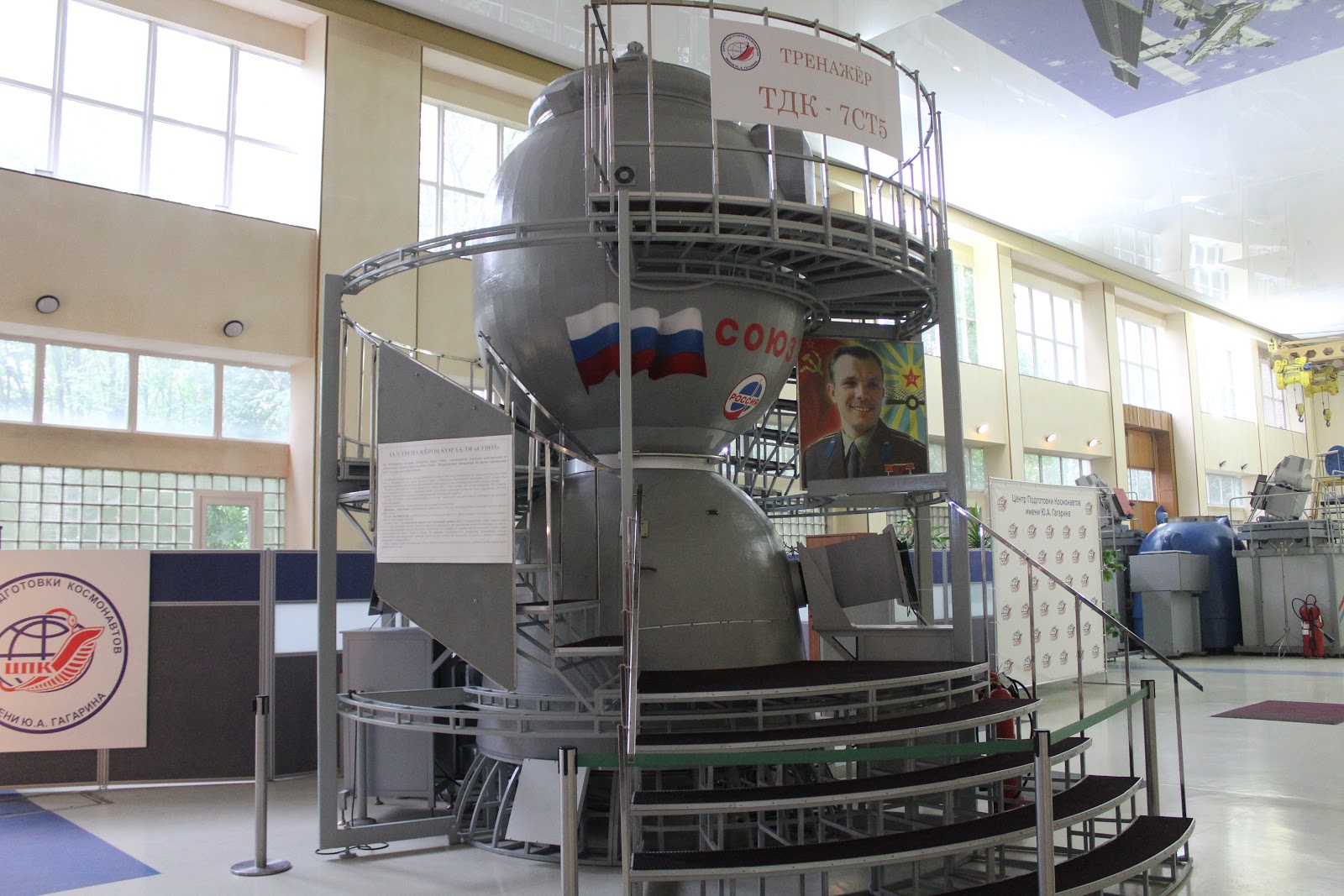
First, we are escorted to the Soyuz Hall, here are full-size models of the ships, on which the astronauts both now and now go into orbit and reach the ISS. "Unions" were developed in the 1960s in the USSR and were originally intended to fly around the moon and return to Earth. The first launch of the "Union" ended in tragedy in 1967, then the cosmonaut Komarov was killed. After this, the spacecraft systems were substantially refined, now the Union is considered the safest spacecraft. In the late 1970s, the Progress cargo ship was created at the Soyuz base.
"Union" consists of three compartments:
In the upper compartment, the astronauts sleep and rest during a long, up to 2-3 days, flight to the ISS. Here is a space toilet, which works on the principle of a vacuum cleaner. The middle section is also a descent module, in which astronauts return to Earth (the upper and lower sections are burned in the atmosphere).
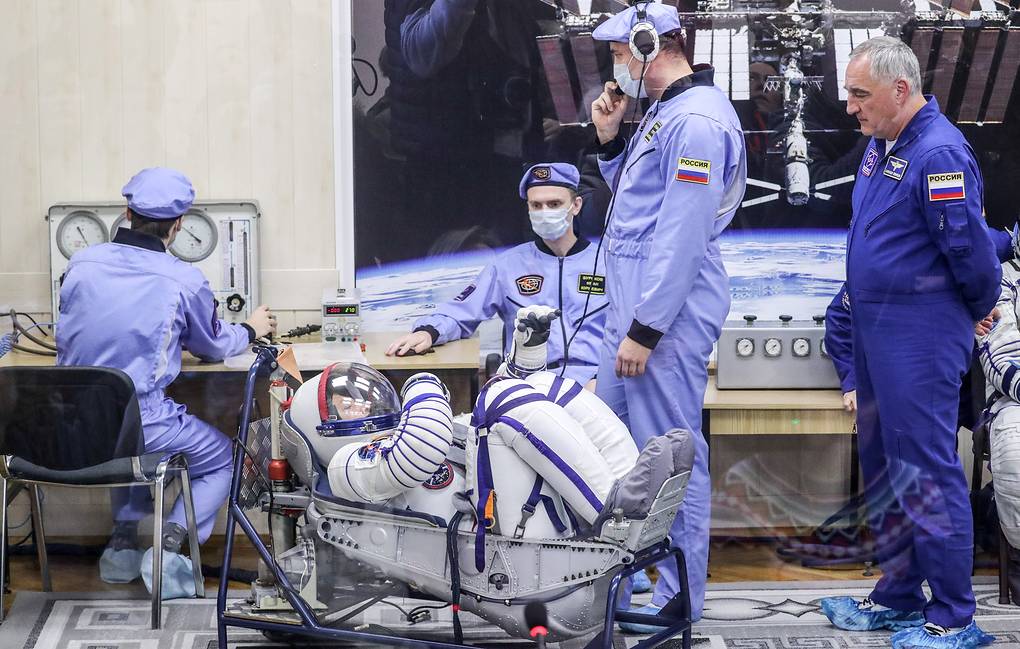
During takeoff, the astronauts lie in the fetal position, so that overloads reaching 8 g act in the direction from the chest to the back. The hull of the ship is made of aluminum alloy in the form of an aerodynamic headlight. Outside, the middle compartment is protected by a heat shield.
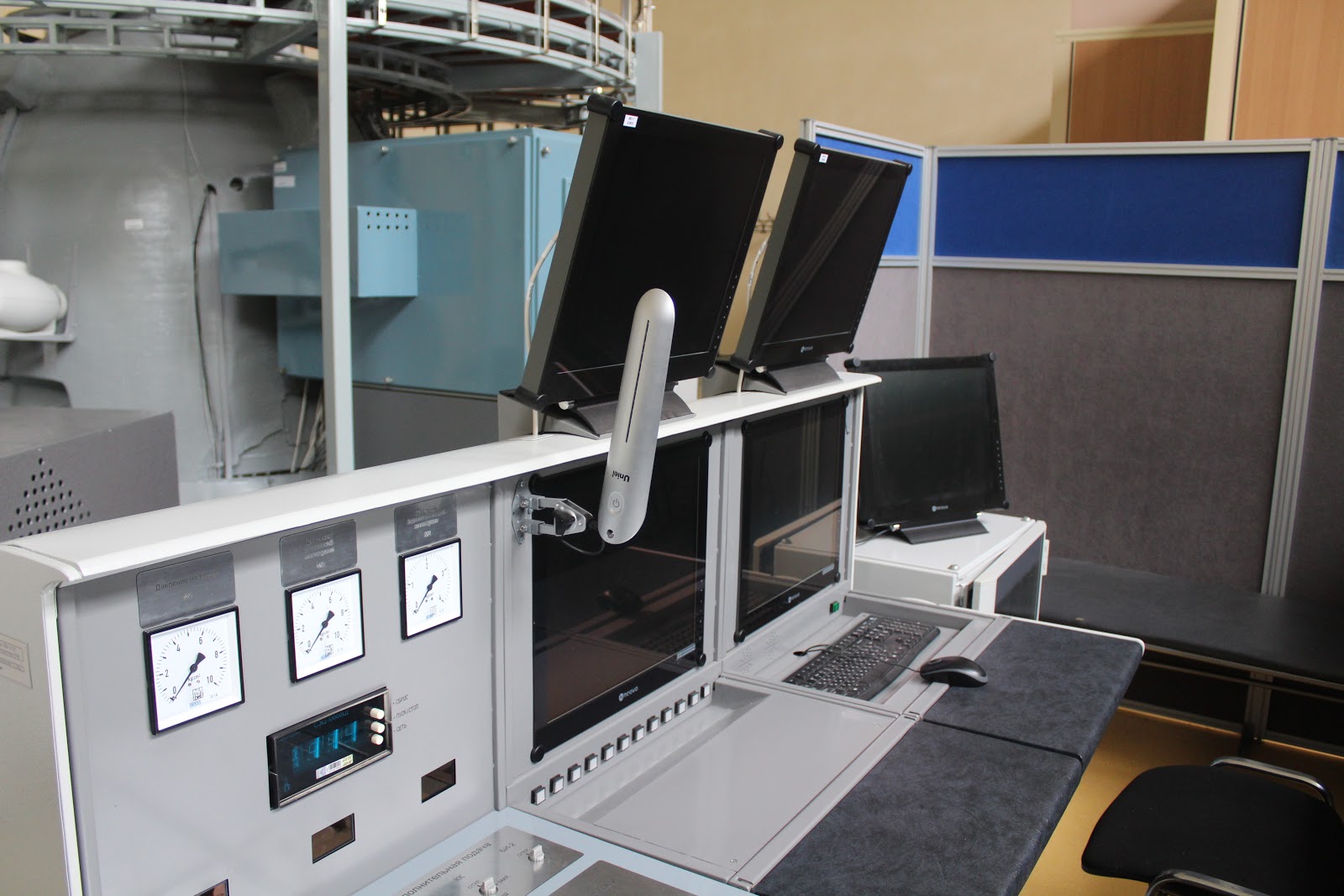
On the simulator, the astronauts work out the process of controlling the Soyuz from the start from the Earth to docking with the station. It simulates the approach, mooring, docking, uncoupling, communication with the ISS, launching into orbit, descending from orbit and landing with conducting final operations.

Here the expert commission takes exams.
The astronauts are trained for all possible flight scenarios, so each applicant’s body is subjected to various ordeals. The Center uses for this purpose flying laboratories, centrifuges, hydro laboratories, pressure chambers, isolation cameras, heat chambers.
Readiness for overloads is trained in future astronauts using a centrifuge. The Center operates a centrifugal TsF-18, which can create overloads in the range from 1 to 30 g with orientation vector overload in any given direction, with adjustment in a wide range of temperature, pressure, humidity and gas composition inside the cabin. The centrifuge rotates at an insane speed reaching 70 revolutions per minute. An unprepared person may lose consciousness. The weight of the whole structure reaches 305 tons.
When entering the dense layers of the atmosphere, the descent vehicle heats up to a thousand degrees, so the astronauts' spacesuits are equipped with a thermal control system. But if she suddenly refuses, the body should be ready for elevated temperatures. Therefore, to prepare for the descent, astronauts pass the heat chamber test. They are placed for 1 hour in a sauna with a temperature of 100 degrees and a humidity of 50%. For example, the record for being in a sauna at 110 degrees is 17 minutes.

Landing the descent vehicle usually takes place exactly according to the flight plan. But there are abnormal situations, and a small inaccuracy in the operation of systems can lead to a deviation of a couple of thousand kilometers. The device can land in any climatic zone of the Earth, in the desert, forest, ocean, so the astronauts have a wearable emergency reserve, which is always in the descent capsule. These include flashlights, a first-aid kit, a smoke rocket, a walkie-talkie, a whistle to scare away sharks, never-burning matches, a titanium saw for sawing trees. Previously, the kit also included a special pistol with 3 barrels: one barrel is a rocket launcher, the second for small fraction, the third for large canister. The pistol appeared in the emergency reserve after the landing of Leonov and Belyaev in the taiga, when they were searched for 2 days (this is shown in the remarkable film “Time of the First”). In 2000, at the insistence of the Americans, the pistol was replaced with a machete.
Once a year, cosmonaut candidates are landed in the taiga, desert or ocean with a similar emergency supply of provisions and equipment. Task: survive a few days and get to the camp, where they are waiting for them to help.
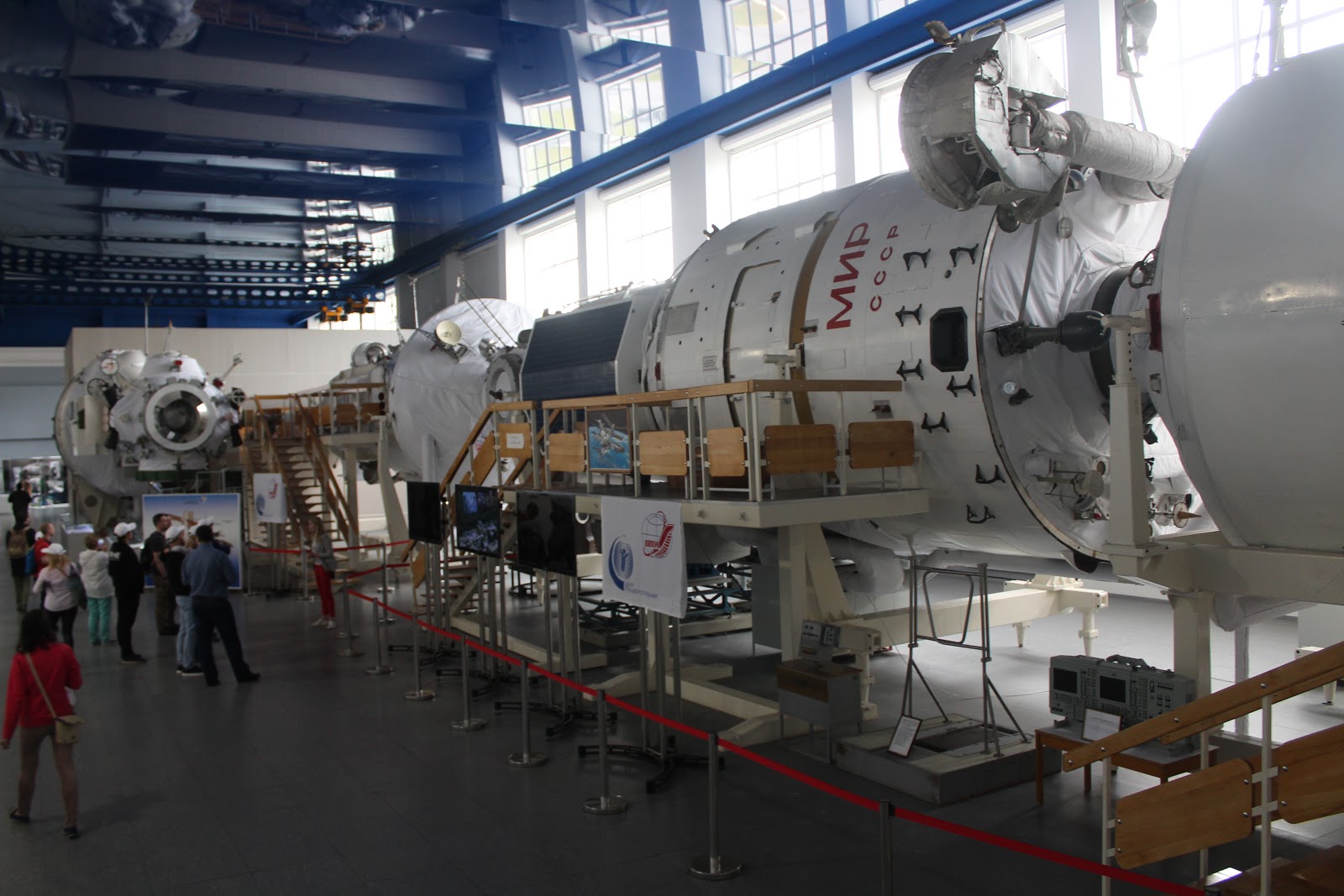
We pass further into the hall with a full-size model of the Mir space station.
The Mira modules were previously used to train astronauts to work on the ISS. Now this hall already has historical significance, here we learned about life inside the station, about the details of space life and work in space.

There is no shower at the station, so the astronauts wipe themselves with wet towels. Once, a shower cabin was delivered to the Mir station, but due to the lack of gravity, soap and water stuck to the body, and the astronauts had to wipe themselves and the cabin. As a result, our guys remade the shower into a sauna, and they even were delivered brooms into orbit. But as a result, due to sudden changes in temperature, without sufficiently effective ventilation and drying, a fungus appeared at the station, so they decided to refuse showers. Actually, an undiluted fungus at the Mir station, whose disputes in conditions of weightlessness pose a threat to the crew’s life, was one of the reasons for the station’s withdrawal from orbit.

The astronauts wash their hair with dry shampoo, which must be rubbed into the hair and scalp, and then wiped off with a wet towel. Toothpaste is swallowed, because in zero gravity it is impossible to spit because of the surrounding equipment and ventilation system. Also, due to the lack of gravity, there is no pressure in the bladder, so a person simply does not feel its filling, and astronauts need to visit the toilet every 3 hours so that there are no incidents.

There are no washing machines at the station, so after unloading the arriving Progress dirty clothes and other garbage are simply loaded into ships that, undocked, burn in dense layers of the atmosphere, nothing remains in orbit.
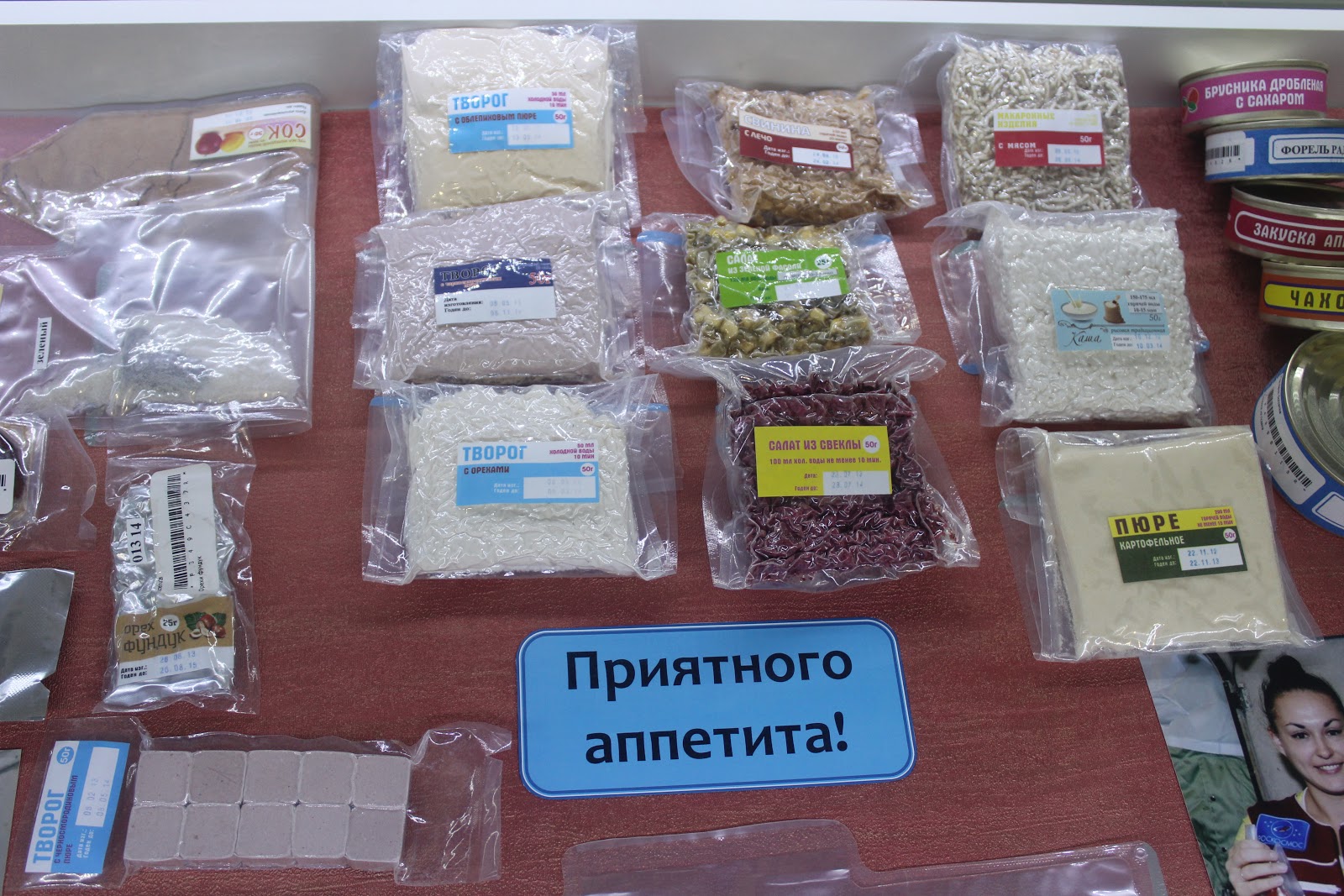
Space food. All food is sublimated (dehydrated) products that are diluted with water. Eat through a straw or a spoon, every 3 hours. Jars are heated in the oven.
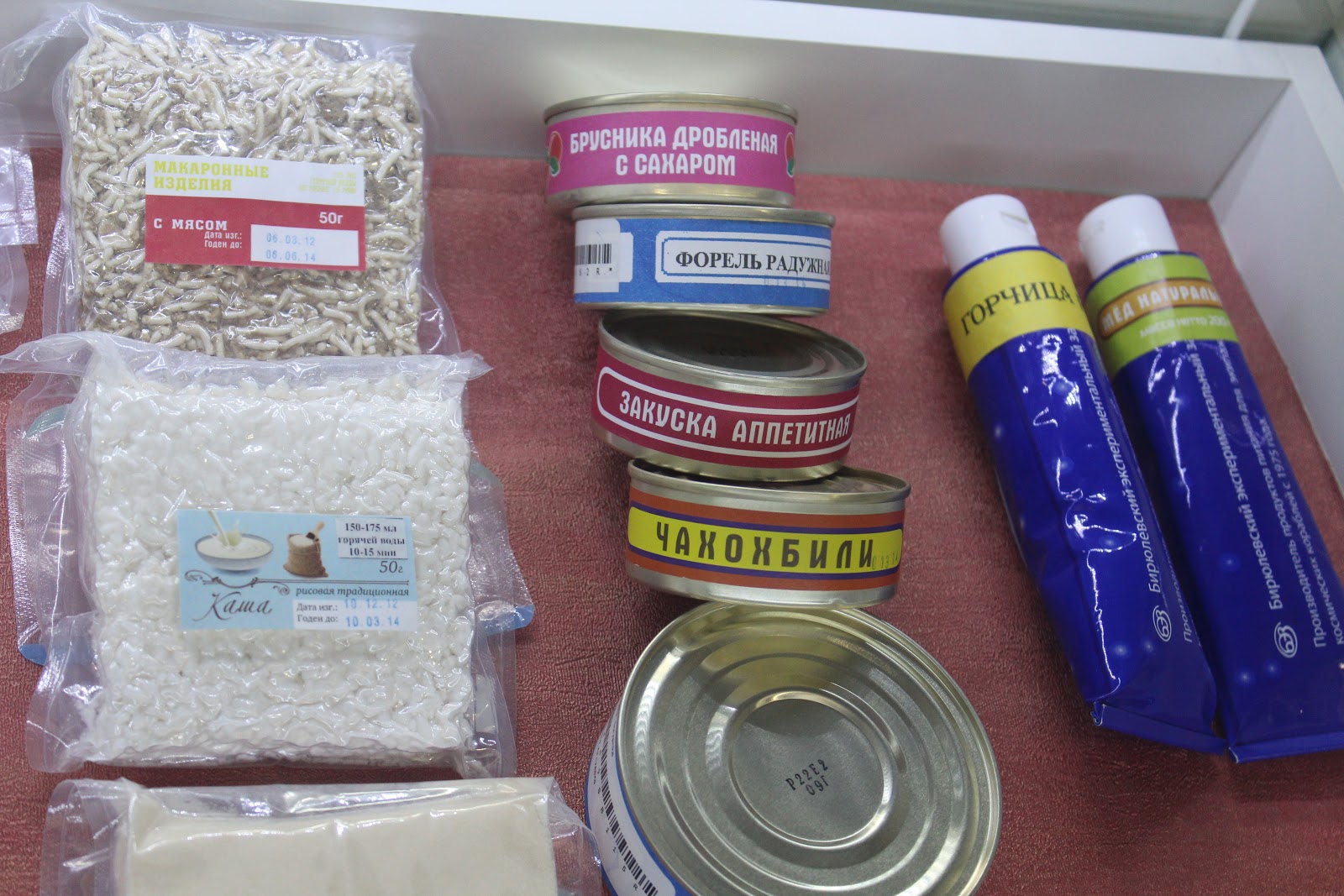
In tubes, food is no longer produced due to the inconvenience of transportation and the weight of the packaging. The weight of one tube is 160 grams, and the weight of a sublimated sachet is 40 grams. In the tubes were only sauces, seasonings and honey. Second courses are in cans. Sublimate almost everything: soups, salads, cereals, juice, desserts. Astronauts are well fed, their diet can be made from a menu of 215 dishes. 3 months before the start, the astronauts begin to eat exclusively on cosmic food, choosing which products they would like to see in orbit. Make your list, after that an individual 16 daily ration is formed for them, which will not be repeated. It is curious that taste buds in microgravity conditions change due to changes in the blood circulation process, therefore, the perception of food also changes. For example, the sour can be sweet, and vice versa, so astronauts in orbit often change their food with each other. The astronaut's daily consumption should be at least 3000 kilocalories, only 5 meals: breakfast, lunch and dinner, and between them two snacks.
Each country brings its own food. Foreigners are very fond of our cottage cheese with nuts, only we do this, so our astronauts use it as a currency at the station and can exchange the cottage cheese for some equipment they need.
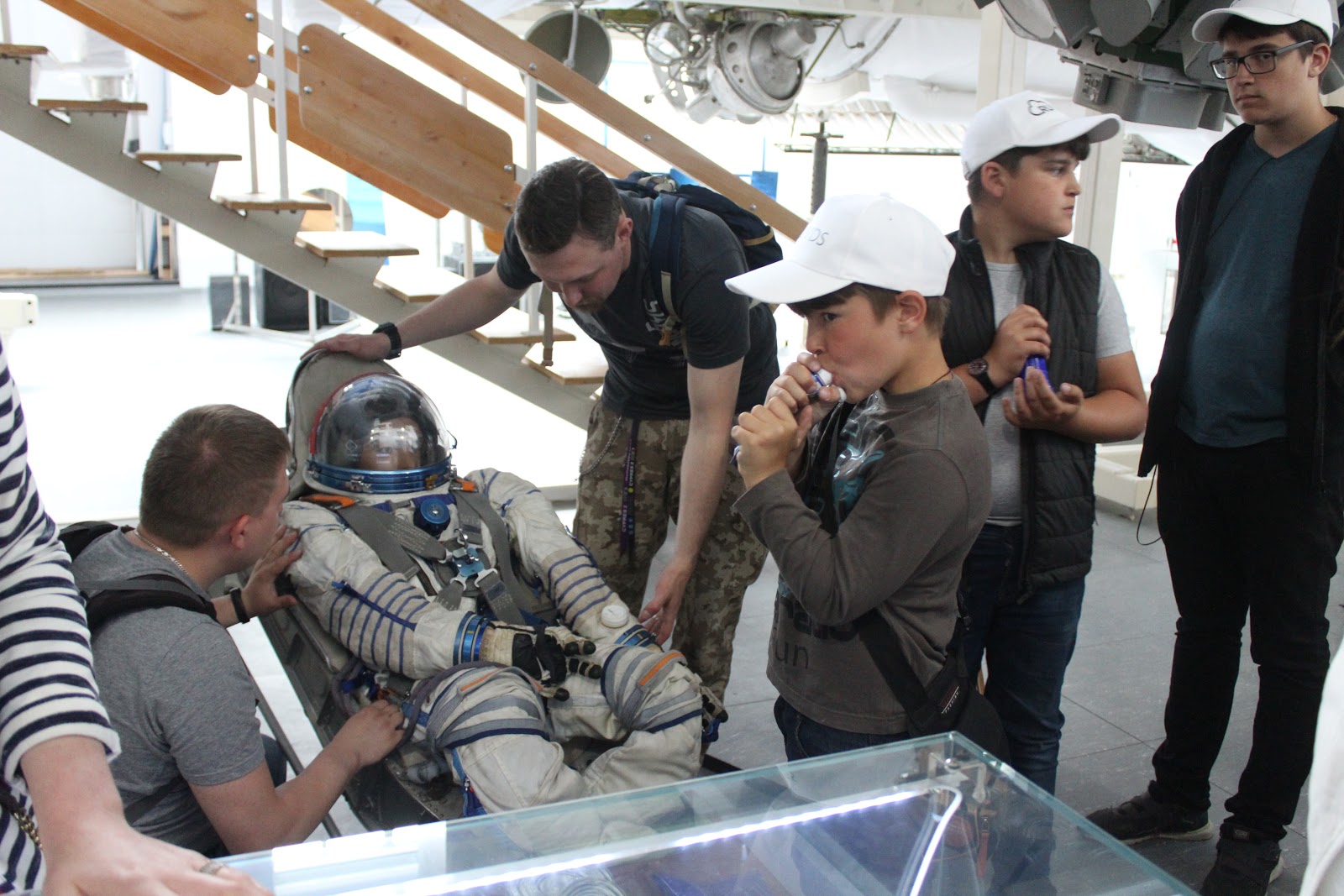
The Sokol space suit is a Soviet space suit that all astronauts wear on board the ship. Over the decades, spacesuits have evolved greatly, now there is even a special roller inside to scratch your nose. The growth of astronauts can now be up to 190 cm, but the height of the sitting should not be more than 99 cm, this limitation is determined by the size of the Kazbek anti-overload chair, on which the cosmonaut lies. And the dimensions of the seat itself are dictated by the available volume in the descent vehicle. For proper distribution of the load over the entire surface of the body, the bed under the chair is cast individually, using a plaster cast of the cosmonaut's back.
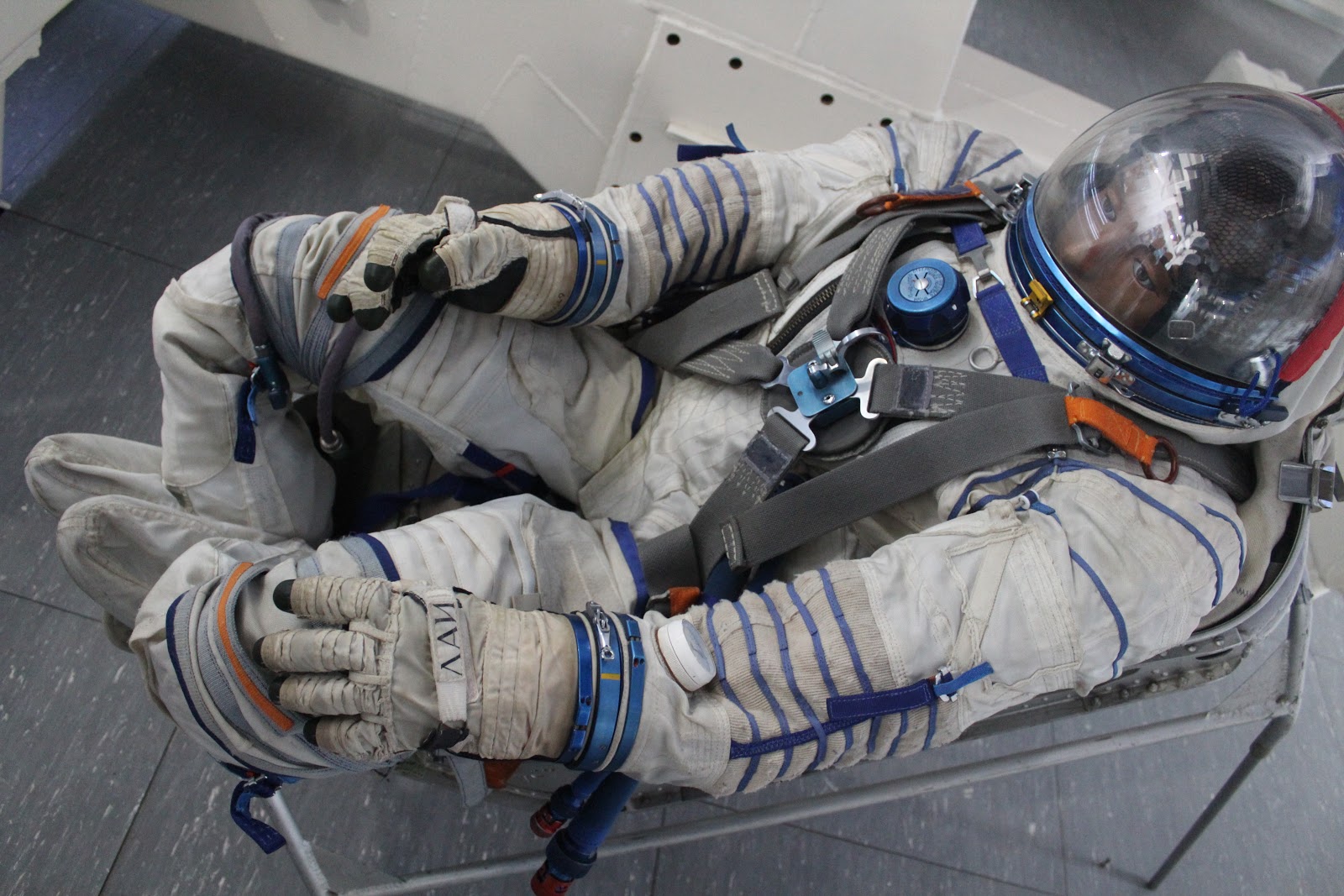
Gloves on spacesuits are signed so as not to confuse yours with someone else's - each spacesuit is created according to individual measures of the cosmonaut. In the photo - “space suit” A. Lazutkina. (LAI).
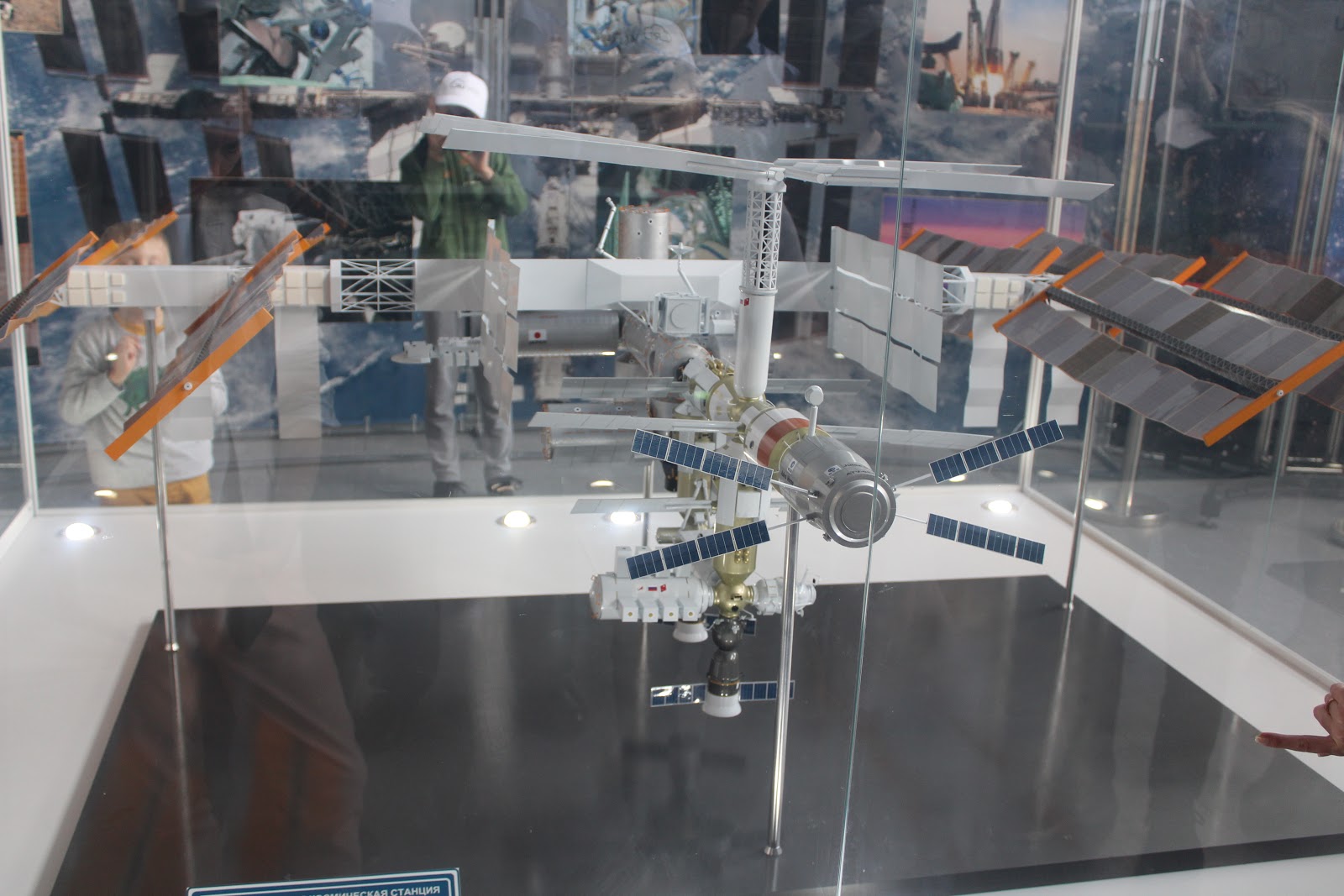
Layout of the ISS, scale 1:50.
ISS has been in operation since 1998. Earlier it was planned that the station will fly until 2020, now the term was extended until 2024. The design of the ISS is assembled according to the modular principle. Such a big Lego for adults (for very large adults). Served modules, or blocks, are disconnected and stoked in the ocean, new ones are put in their place. A total of 23 countries are participating in the project. This is the most expensive design of all existing in the world, according to various estimates, the cost of the ISS exceeds 100-150 billion dollars.
Also in the Center is an exact copy of the Russian segment of the ISS, here the astronauts are preparing to fulfill their mission. Every astronaut has a scientific program that he must perform in space. The hall also takes examinations on the skills of working at the station.
An open set of astronauts announces Roscosmos. The first such set was held in October 2012, the second - in August 2018. The set takes place in two stages: correspondence and full-time. Of the 420 applicants in 2018, 27 people were able to go into the second round (only one woman among them), 8 people eventually took the training course, all men. Of the 8 people recruited in 2012, two have already left the squadron, the six remaining have not yet flown. In June 2019, Roscosmos announced the third open set of cosmonauts. This time, more active participation of the girls is expected, according to Rogozin, in order to balance the detachment that has recently become “too masculine.” Now there is only one girl Anna Kikina in the cosmonaut detachment, we just found her in training at the Center.

How is the selection? First analyze submitted applications. At this stage, almost a quarter of applicants are eliminated. Anyone can send an application, there are no restrictions. But historically, it turned out that mainly cosmonauts come from pilots.
All past the correspondence tour are waiting for face-to-face tests: checking physical training and interviews.
Physical training: running or skiing, swimming, pulling up, exercises on uneven bars, speed and shuttle running, trampoline jumping, diving, treadmill on a simulator aboard the station.
They check the level of education: exams in mathematics, physics, computer technology, English, cultural studies are taken, dictation in the Russian language is written.
They test professional aptitude: knowledge of the history of world and domestic cosmonautics, the basics of manned cosmonautics, the definition of capabilities for the study of space technology, test work (testing using technical means).
Next are a psychological interview.
They also check engineering skills: it is necessary to study the manual for one of the onboard systems of a manned spacecraft and tell the examiners how they work. The deadline is 1 day.
Those who have completed a full-time tour are waiting for a two-year course of general space training. Then you need to pass exams and qualify. And only after that, perhaps, the astronaut will fall into the crew and go into space. The total period of preparation of an astronaut is 10 years.

One of the most difficult exams is the test of silence and solitude. During the exam, the future astronaut for 3 days is placed in a fully isolated isolation chamber. All this time, a person without sleep performs tests and exercises, without any connection with the outside world. Just before our arrival, such exams were held at the Center, and all 8 candidates for cosmonauts successfully coped with them.

Current schedule of cosmonauts. Call signs listeners have asked us not to show. Classes for astronauts begin at 9 am and continue until 6 pm
Now there are 25 people in the Russian cosmonaut corps. Of these, 12 people have no space flight experience, some have been waiting for their turn for 13 years. The Russian crew on the ISS consists of two people, that is, only one cosmonaut arrives at the station at each station — the commander of the Soyuz spacecraft. Only experienced cosmonauts who have flown to the ISS are assigned to the flight. So, July 20, 2019 Skvortsov A.A. should fly, this will be his third flight to the station.
Candidates from the 2018 set, at best, will be able to fly to the ISS in 2022-2024. In reality, most likely, they will fly in the years 2028-2030, probably on a new Russian ship, the Federation. And they will prepare to fly to the moon and to mars.
We could not resist and asked what the salary of astronauts. So, the candidate for astronauts receives 60 thousand rubles. The cosmonaut who came to the squad has a salary of 110 thousand rubles. The cosmonauts of the first class (three flights) and the second class (two flights) - 300 thousand. The average salary is 170 thousand rubles. Most of all, our astronauts earn when they are in space, for 6 months of being in orbit, their earnings can range from 130 to 150 thousand dollars.
At the same time, the cosmonaut is the most expensive profession in the world. Today, the cost of one year of training for one cosmonaut costs approximately $ 55 million.
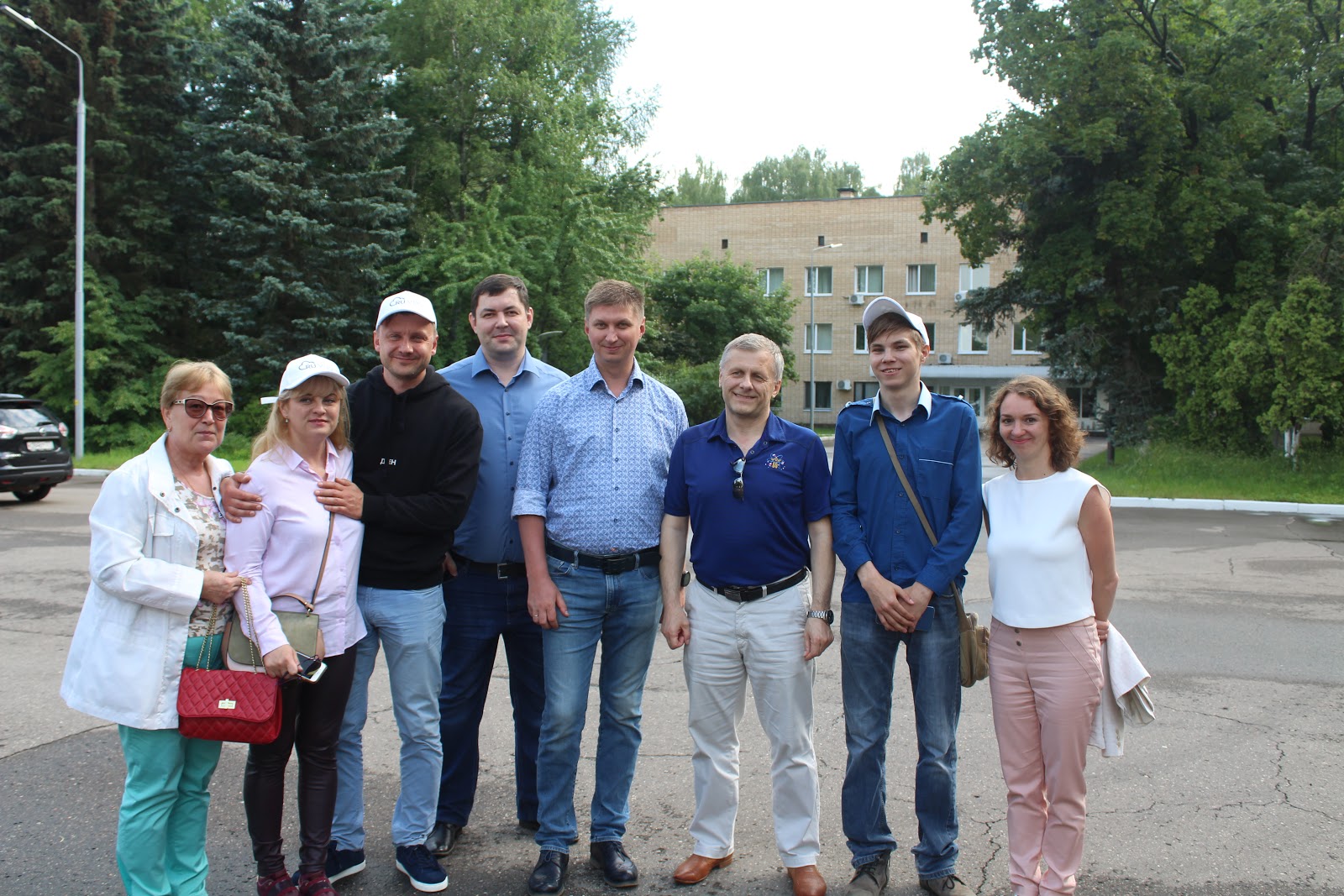
At the end of our tour at the Center, we met the current cosmonaut of the Roskosmos cosmonaut Borisenko Andrei Ivanovich. He flew the ISS twice, in 2012 and 2016.
Cosmonauts' cars are given a special series of state numbers. In the 1980s, they were given registration marks with "Moscow" IMO letters and numbers corresponding to the cosmonaut number according to the Russian classification. So, cosmonaut number 50 Viktor Savinykh after the flight received a “0050 MMO” sign. The letter code was located near Moscow because it was engaged in this by the traffic police of Star City, to which all cosmonauts were assigned. After the transition to the Russian car registration system, the tradition has been preserved. Only the numbers became three, and the letters turned into TMP. So, Andrei Ivanovich on car sign "T110MR." In total, 122 cosmonauts from Russia and the USSR have been in space today.
* * *
On July 20, the next manned launch of the Soyuz spacecraft will take place. We wish cosmonauts a successful start and flight, and from the winner of our competition we are waiting for a reporting post about a trip to Baikonur :) In the meantime, you can take part in the new prize draw from RUVDS, details are on the website .
Vlad Vvzvlad turned out to be the closest of all; on July 20 he will go to Baikonur to see the launch of the manned spacecraft Soyuz.
The prize for the 3rd place was participation in a group excursion to the Cosmonaut Training Center in Star City. Last Friday, we were able to get there, now we are sharing the knowledge gained about the training of astronauts, how to get into the squadron, and whether it is possible to become an astronaut at all in our time.
')

A little information about Star City. It is a closed city (about 6,000 inhabitants), here is the only Cosmonaut Training Center in Russia. All cosmonauts, including foreign ones, undergo pre-flight training for the flight to the ISS. Many astronauts in Star City not only work, but also live.
The center was established in 1960 to prepare a person for space flight, then the town was called Green, it is located next to the town of Schelkovo, 25 km from Moscow.

Our tour began with the Star City checkpoint. It is impossible to order an individual excursion at the Center; only a group tour through agencies is acquired. At the same time, we ordered a tour for 2 months, before there were no empty seats. 2 weeks before arrival you must submit a list of participants, for foreigners 45 days in advance. The document passes several approvals, we counted 9 signatures and seals on our entry sheet. Before entering the standard verification of documents, and we get to the Center.

First, we are escorted to the Soyuz Hall, here are full-size models of the ships, on which the astronauts both now and now go into orbit and reach the ISS. "Unions" were developed in the 1960s in the USSR and were originally intended to fly around the moon and return to Earth. The first launch of the "Union" ended in tragedy in 1967, then the cosmonaut Komarov was killed. After this, the spacecraft systems were substantially refined, now the Union is considered the safest spacecraft. In the late 1970s, the Progress cargo ship was created at the Soyuz base.
"Union" consists of three compartments:
- The lower, instrument-aggregate compartment - here is located the engine of a soft landing, braking engines, solar batteries, fuel tanks. It is not used for simulators, its weight reaches 7 tons.
- The middle compartment is a command module. This is a sealed compartment in which the crew is located since the launch of the ship.
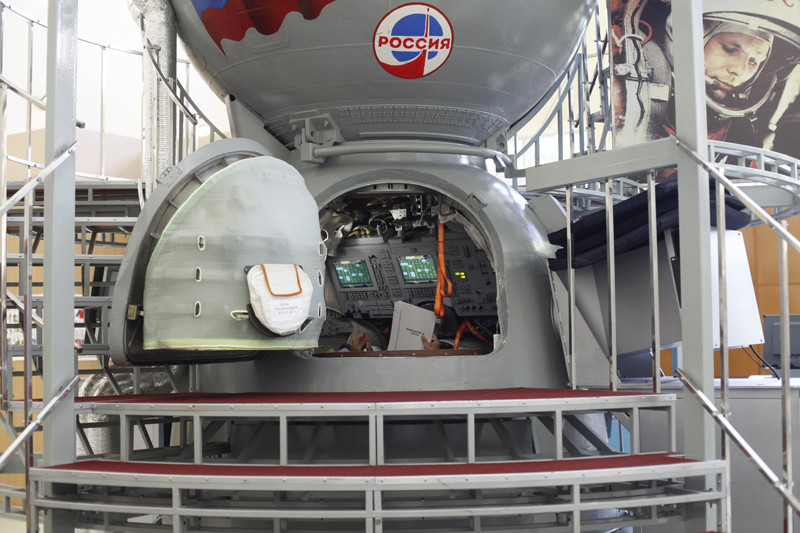
- The upper, domestic compartment, with a docking unit, places in it loads that astronauts carry with them to the ISS. More than 1 kilogram of personal belongings, they can not take with them. By the way, when cargo Progresses are sent to the ISS, personal parcels for astronauts are put to the very end, so that first they unload all the cargo brought, and only then they can get to the desired packages.
In the upper compartment, the astronauts sleep and rest during a long, up to 2-3 days, flight to the ISS. Here is a space toilet, which works on the principle of a vacuum cleaner. The middle section is also a descent module, in which astronauts return to Earth (the upper and lower sections are burned in the atmosphere).

During takeoff, the astronauts lie in the fetal position, so that overloads reaching 8 g act in the direction from the chest to the back. The hull of the ship is made of aluminum alloy in the form of an aerodynamic headlight. Outside, the middle compartment is protected by a heat shield.

On the simulator, the astronauts work out the process of controlling the Soyuz from the start from the Earth to docking with the station. It simulates the approach, mooring, docking, uncoupling, communication with the ISS, launching into orbit, descending from orbit and landing with conducting final operations.

Here the expert commission takes exams.
Tests that astronauts pass
The astronauts are trained for all possible flight scenarios, so each applicant’s body is subjected to various ordeals. The Center uses for this purpose flying laboratories, centrifuges, hydro laboratories, pressure chambers, isolation cameras, heat chambers.
▍ Centrifuge
Readiness for overloads is trained in future astronauts using a centrifuge. The Center operates a centrifugal TsF-18, which can create overloads in the range from 1 to 30 g with orientation vector overload in any given direction, with adjustment in a wide range of temperature, pressure, humidity and gas composition inside the cabin. The centrifuge rotates at an insane speed reaching 70 revolutions per minute. An unprepared person may lose consciousness. The weight of the whole structure reaches 305 tons.
▍Thermocamera
When entering the dense layers of the atmosphere, the descent vehicle heats up to a thousand degrees, so the astronauts' spacesuits are equipped with a thermal control system. But if she suddenly refuses, the body should be ready for elevated temperatures. Therefore, to prepare for the descent, astronauts pass the heat chamber test. They are placed for 1 hour in a sauna with a temperature of 100 degrees and a humidity of 50%. For example, the record for being in a sauna at 110 degrees is 17 minutes.
▍ Survival Tests

Landing the descent vehicle usually takes place exactly according to the flight plan. But there are abnormal situations, and a small inaccuracy in the operation of systems can lead to a deviation of a couple of thousand kilometers. The device can land in any climatic zone of the Earth, in the desert, forest, ocean, so the astronauts have a wearable emergency reserve, which is always in the descent capsule. These include flashlights, a first-aid kit, a smoke rocket, a walkie-talkie, a whistle to scare away sharks, never-burning matches, a titanium saw for sawing trees. Previously, the kit also included a special pistol with 3 barrels: one barrel is a rocket launcher, the second for small fraction, the third for large canister. The pistol appeared in the emergency reserve after the landing of Leonov and Belyaev in the taiga, when they were searched for 2 days (this is shown in the remarkable film “Time of the First”). In 2000, at the insistence of the Americans, the pistol was replaced with a machete.
Once a year, cosmonaut candidates are landed in the taiga, desert or ocean with a similar emergency supply of provisions and equipment. Task: survive a few days and get to the camp, where they are waiting for them to help.

We pass further into the hall with a full-size model of the Mir space station.
The Mira modules were previously used to train astronauts to work on the ISS. Now this hall already has historical significance, here we learned about life inside the station, about the details of space life and work in space.

There is no shower at the station, so the astronauts wipe themselves with wet towels. Once, a shower cabin was delivered to the Mir station, but due to the lack of gravity, soap and water stuck to the body, and the astronauts had to wipe themselves and the cabin. As a result, our guys remade the shower into a sauna, and they even were delivered brooms into orbit. But as a result, due to sudden changes in temperature, without sufficiently effective ventilation and drying, a fungus appeared at the station, so they decided to refuse showers. Actually, an undiluted fungus at the Mir station, whose disputes in conditions of weightlessness pose a threat to the crew’s life, was one of the reasons for the station’s withdrawal from orbit.

The astronauts wash their hair with dry shampoo, which must be rubbed into the hair and scalp, and then wiped off with a wet towel. Toothpaste is swallowed, because in zero gravity it is impossible to spit because of the surrounding equipment and ventilation system. Also, due to the lack of gravity, there is no pressure in the bladder, so a person simply does not feel its filling, and astronauts need to visit the toilet every 3 hours so that there are no incidents.

There are no washing machines at the station, so after unloading the arriving Progress dirty clothes and other garbage are simply loaded into ships that, undocked, burn in dense layers of the atmosphere, nothing remains in orbit.

Space food. All food is sublimated (dehydrated) products that are diluted with water. Eat through a straw or a spoon, every 3 hours. Jars are heated in the oven.

In tubes, food is no longer produced due to the inconvenience of transportation and the weight of the packaging. The weight of one tube is 160 grams, and the weight of a sublimated sachet is 40 grams. In the tubes were only sauces, seasonings and honey. Second courses are in cans. Sublimate almost everything: soups, salads, cereals, juice, desserts. Astronauts are well fed, their diet can be made from a menu of 215 dishes. 3 months before the start, the astronauts begin to eat exclusively on cosmic food, choosing which products they would like to see in orbit. Make your list, after that an individual 16 daily ration is formed for them, which will not be repeated. It is curious that taste buds in microgravity conditions change due to changes in the blood circulation process, therefore, the perception of food also changes. For example, the sour can be sweet, and vice versa, so astronauts in orbit often change their food with each other. The astronaut's daily consumption should be at least 3000 kilocalories, only 5 meals: breakfast, lunch and dinner, and between them two snacks.
Each country brings its own food. Foreigners are very fond of our cottage cheese with nuts, only we do this, so our astronauts use it as a currency at the station and can exchange the cottage cheese for some equipment they need.

The Sokol space suit is a Soviet space suit that all astronauts wear on board the ship. Over the decades, spacesuits have evolved greatly, now there is even a special roller inside to scratch your nose. The growth of astronauts can now be up to 190 cm, but the height of the sitting should not be more than 99 cm, this limitation is determined by the size of the Kazbek anti-overload chair, on which the cosmonaut lies. And the dimensions of the seat itself are dictated by the available volume in the descent vehicle. For proper distribution of the load over the entire surface of the body, the bed under the chair is cast individually, using a plaster cast of the cosmonaut's back.

Gloves on spacesuits are signed so as not to confuse yours with someone else's - each spacesuit is created according to individual measures of the cosmonaut. In the photo - “space suit” A. Lazutkina. (LAI).

Layout of the ISS, scale 1:50.
ISS has been in operation since 1998. Earlier it was planned that the station will fly until 2020, now the term was extended until 2024. The design of the ISS is assembled according to the modular principle. Such a big Lego for adults (for very large adults). Served modules, or blocks, are disconnected and stoked in the ocean, new ones are put in their place. A total of 23 countries are participating in the project. This is the most expensive design of all existing in the world, according to various estimates, the cost of the ISS exceeds 100-150 billion dollars.
Also in the Center is an exact copy of the Russian segment of the ISS, here the astronauts are preparing to fulfill their mission. Every astronaut has a scientific program that he must perform in space. The hall also takes examinations on the skills of working at the station.
How is the training in astronauts
An open set of astronauts announces Roscosmos. The first such set was held in October 2012, the second - in August 2018. The set takes place in two stages: correspondence and full-time. Of the 420 applicants in 2018, 27 people were able to go into the second round (only one woman among them), 8 people eventually took the training course, all men. Of the 8 people recruited in 2012, two have already left the squadron, the six remaining have not yet flown. In June 2019, Roscosmos announced the third open set of cosmonauts. This time, more active participation of the girls is expected, according to Rogozin, in order to balance the detachment that has recently become “too masculine.” Now there is only one girl Anna Kikina in the cosmonaut detachment, we just found her in training at the Center.

How is the selection? First analyze submitted applications. At this stage, almost a quarter of applicants are eliminated. Anyone can send an application, there are no restrictions. But historically, it turned out that mainly cosmonauts come from pilots.
All past the correspondence tour are waiting for face-to-face tests: checking physical training and interviews.
Physical training: running or skiing, swimming, pulling up, exercises on uneven bars, speed and shuttle running, trampoline jumping, diving, treadmill on a simulator aboard the station.
They check the level of education: exams in mathematics, physics, computer technology, English, cultural studies are taken, dictation in the Russian language is written.
They test professional aptitude: knowledge of the history of world and domestic cosmonautics, the basics of manned cosmonautics, the definition of capabilities for the study of space technology, test work (testing using technical means).
Next are a psychological interview.
They also check engineering skills: it is necessary to study the manual for one of the onboard systems of a manned spacecraft and tell the examiners how they work. The deadline is 1 day.
Those who have completed a full-time tour are waiting for a two-year course of general space training. Then you need to pass exams and qualify. And only after that, perhaps, the astronaut will fall into the crew and go into space. The total period of preparation of an astronaut is 10 years.

One of the most difficult exams is the test of silence and solitude. During the exam, the future astronaut for 3 days is placed in a fully isolated isolation chamber. All this time, a person without sleep performs tests and exercises, without any connection with the outside world. Just before our arrival, such exams were held at the Center, and all 8 candidates for cosmonauts successfully coped with them.

Current schedule of cosmonauts. Call signs listeners have asked us not to show. Classes for astronauts begin at 9 am and continue until 6 pm
Now there are 25 people in the Russian cosmonaut corps. Of these, 12 people have no space flight experience, some have been waiting for their turn for 13 years. The Russian crew on the ISS consists of two people, that is, only one cosmonaut arrives at the station at each station — the commander of the Soyuz spacecraft. Only experienced cosmonauts who have flown to the ISS are assigned to the flight. So, July 20, 2019 Skvortsov A.A. should fly, this will be his third flight to the station.
Candidates from the 2018 set, at best, will be able to fly to the ISS in 2022-2024. In reality, most likely, they will fly in the years 2028-2030, probably on a new Russian ship, the Federation. And they will prepare to fly to the moon and to mars.
How much do astronauts earn
We could not resist and asked what the salary of astronauts. So, the candidate for astronauts receives 60 thousand rubles. The cosmonaut who came to the squad has a salary of 110 thousand rubles. The cosmonauts of the first class (three flights) and the second class (two flights) - 300 thousand. The average salary is 170 thousand rubles. Most of all, our astronauts earn when they are in space, for 6 months of being in orbit, their earnings can range from 130 to 150 thousand dollars.
At the same time, the cosmonaut is the most expensive profession in the world. Today, the cost of one year of training for one cosmonaut costs approximately $ 55 million.

At the end of our tour at the Center, we met the current cosmonaut of the Roskosmos cosmonaut Borisenko Andrei Ivanovich. He flew the ISS twice, in 2012 and 2016.
Cosmonauts' cars are given a special series of state numbers. In the 1980s, they were given registration marks with "Moscow" IMO letters and numbers corresponding to the cosmonaut number according to the Russian classification. So, cosmonaut number 50 Viktor Savinykh after the flight received a “0050 MMO” sign. The letter code was located near Moscow because it was engaged in this by the traffic police of Star City, to which all cosmonauts were assigned. After the transition to the Russian car registration system, the tradition has been preserved. Only the numbers became three, and the letters turned into TMP. So, Andrei Ivanovich on car sign "T110MR." In total, 122 cosmonauts from Russia and the USSR have been in space today.
* * *
On July 20, the next manned launch of the Soyuz spacecraft will take place. We wish cosmonauts a successful start and flight, and from the winner of our competition we are waiting for a reporting post about a trip to Baikonur :) In the meantime, you can take part in the new prize draw from RUVDS, details are on the website .
Source: https://habr.com/ru/post/457062/
All Articles
